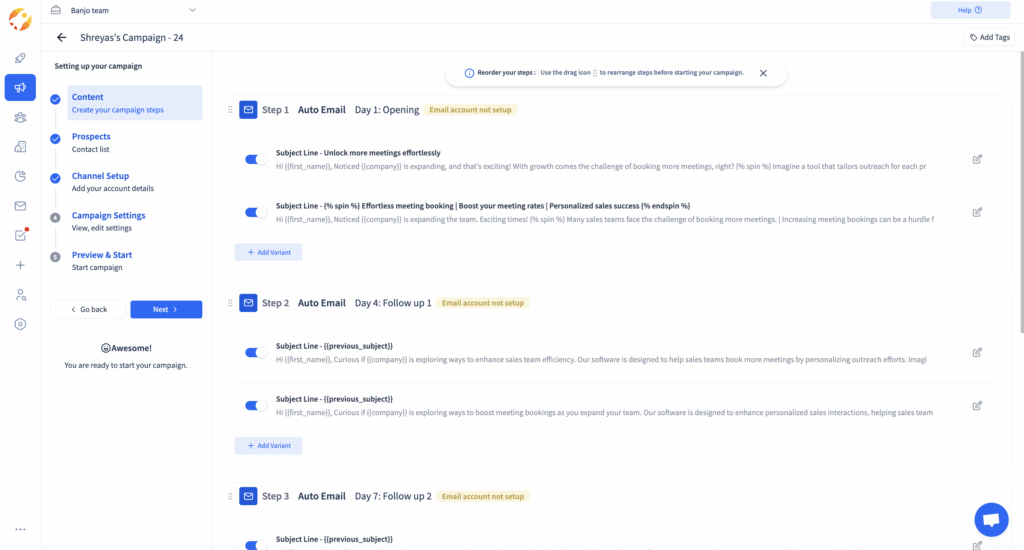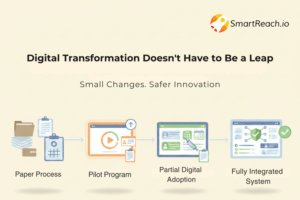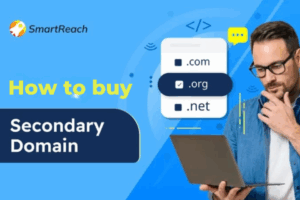Email Segmentation Guide: Strategy, Benefits & Best Practices
Email segmentation is the process of dividing your email list into smaller groups based on shared characteristics like behavior, engagement, or purchase intent.
It’s one of the most effective email marketing segmentation strategies for increasing open rates, engagement, and conversions from campaigns.
In this guide, you’ll learn the fundamentals of email segmentation, proven strategies to apply it, and practical tips to build high-performing segmented campaigns.
Let’s get started.
What is email segmentation?
Email segmentation is the practice of dividing an email list into smaller, targeted groups based on shared attributes of the prospects (demographics, behaviour, preferences) so that emails are more relevant, timely, and effective.
What are the benefits of email list segmentation?
Here’s how email segmentation actually creates impact:
- Improved engagement: Prospects receive emails that align with their preferences, increasing open and click-through rates.
- Better conversions: Targeted campaigns nurture leads with the right message at the right time, driving higher sales and responses.
- Higher deliverability rates: Segmenting emails by engagement levels keeps your sender reputation healthy and prevents emails from landing in spam folders.
- Reduced unsubscribe rates: When emails match user intent, fewer people opt out of your list.
- Enhanced insights: Segmentation helps you understand which audience groups respond best, so you can refine future campaigns and optimize ROI.
By building a consistent, data-backed email segmentation strategy, brands can maintain healthy sender domains, sustain engagement over time, and build trust with their audience.
But even the most perfectly segmented campaign can fall flat if it doesn’t reach real people.
Using an email checker before launch helps ensure your messages reach valid addresses, boosting deliverability and overall campaign success.
5 Proven email segmentation strategies for email marketing
As you go over each strategy, identify what closely aligns with your goals, so you know what to implement first.
1. Create personalized cold email segmentation campaigns
The average response rate for cold emails is 8.5%. But with our insider personalization technique, you can increase it to 10-15%.
Here’s what you need to do:
1.1. Mention their activity on social media
When you target customers based on specific social media activity, mention it in your emails to tell them why you want to connect with them.
For example you can something like –
| “Since you liked our [post topic] post, we wanted to check if you’d be interested in our [product/service name].” |
1.2. Prove you know them in the emails
Use email personalization to go above and beyond to prove you know your customers more than your competitors.
1.3. Highlight their pain points
Use customer research to identify your target customers’ biggest pain points. Be empathetic and prove how your products or services can resolve their issues.
If you’re reaching out to startups, create and send them the perfect pitch deck highlighting your knowledge of their industry and pain points.
Your pitch deck should include your customer’s problem or pain points, your solution, and the long-term benefits of their relationship with you.
1.4. Mention where you found them
Tell your new subscribers where you found their contact details to build trust and rapport. This shows your customers they are not just another number for you.
It also proves you worked hard to contact someone you value.
Use sales email templates for cold outreach to send well-structured and relevant emails for more significant results.
2. Encourage newsletter signups with discount codes
If your email opt-in rate is 1.95%, you’re already doing an above-average job.
However, you can increase this to 5% with the right email marketing segmentation strategies.
Here’s what you need to do:
2.1. Create a simple signup form
Too many form fields will discourage your customers from signing up for your newsletter. So, keep things simple and only ask for their email address. Add an optional field for their names.
Forms like this one encourage customers to fill out the form quickly.

Here’s another great example of a simple form by Vinyl Status that attracts new subscribers with a 10% discount in exchange for the visitor’s contact details.

The simple CTA “Save 10% off your order” creates a value-driven offer that lessens the friction to take action.
It also sets clear expectations by highlighting how frequently they will receive emails and includes a transparent disclaimer about receiving text messages.
This builds customer trust by making it clear they can unsubscribe anytime, helping them feel more comfortable sharing contact details.
2.2. Place it in a visible spot
Make it small and strategically on your webpage as long as it’s not distracting your visitor from the main content. Here are some placement strategies to consider:
- Comment Section: Place the form here for visitors who comment on your products or posts.
- Floating Box: This form moves up and down with the relevant content as you scroll on a webpage. Use this on web pages where your primary motive is to get more email subscribers.
- Pop-Up Screens: Use these for customers scrolling through your products or viewing their checkout pages to move them to purchase your products/services and not abandon their cart.
2.3. Send a confirmation
Use SmartReach.io to validate your email lists for free.
Plus, you can use it to create and send personalized automated emails to your new subscribers.

Personalized email follow-ups inside SmartReach.io
Thank them for subscribing to your newsletter, and include a discount that they can immediately use. Connecting with interested customers immediately will create long-term positive experiences.
2.4. Use communities & social media networks
Set up your brand’s social media accounts and offer discount codes to segment subscribers based on interests and likes.
People who already interact with your brand and consume your content are great targets for your email lists.
Add links to sign up for your newsletter on all your social media platforms and any other community you use to communicate with your customers.
3. Reward customer loyalty with early access to new products/services
Reward loyal customers of your brand with something more than just discounts to keep them engaged and set yourself apart from competitors.
Here’s what you need to do:
3.1. Give your rewards program a name
Pick a name that sparks curiosity and interest in your customers, encouraging them to participate.
This will set you apart from all your competitors. Plus, your customers will feel excited to be a part of something unique.
Don’t tell them what you offer. Instead, tap into why your products/services are a great fit for your customers. This will encourage them to sign up for your email and participate in segmented campaigns specifically designed for loyal customers.
3.2. Reward specific customer actions
Segment your email list based on specific customer purchasing and non-purchasing actions.
For example, you can reward loyal customers for sharing your social media content, engaging in your mobile app, or watching demonstration videos on your website.
3.4 Combine it with other rewards
Grant early access to new products and services to improve your sales funnel and increase your customer lifetime value.
You can also add donations in their name to the charity of their choice, free subscriptions for additional products or services, and free tickets to entertainment events.
Create segments based on your customers’ lifestyles and preferences to introduce more loyalty program rewards. You can also let them redeem points for special rewards of their choice for better email engagement.
3.5. Use gamification for better results
Segment your emails based on holidays and product launches to send discovery games, challenges, competitions, creative games, puzzles, educational games, quizzes, and luck and chance games.
These are great for collecting detailed subscriber data, including their interests and likes/dislikes.
4. Monitor order history for hyper-personalized emails
A personalized call to action has a 202% higher conversion rate than standard CTAs, making personalization one of the most important elements of an email marketing campaign.
Email marketing segmentation based on purchase history offers more accurate data than most other segmentation strategies.
Here’s what to do:
4.1. Gather as much data as possible
Use your CRM software, Google Analytics, and email marketing platform to collect and analyze customer data.
Gather as much data as you can to create a personalized signup page for your customers. In addition to purchase history, segment your email list based on browsing behavior, past interactions, and demographics.
4.2. Encourage customers to sign up
Adding CTAs like “Join our mailing list to get exclusive deals only available to our subscribers” creates urgency and encourages visitors to subscribe to the email newsletter. Use strong CTAs like this to catch your visitors’ attention and convince them to take action.
The following form example checks a lot of our boxes of what a good form should look like.

With a simple but elegant design, with only 3 fields to fill, it won’t distract users from the webpage’s content.
They display the pop-up form only when you click on the signup button above the hero banner.
4.3. Customize recommendations based on buyer’s history
Once you gather all purchase-related information from your visitors, you can send them segmented campaigns based on that.
For example, if it’s a first-time buyer, you can send them an email comparing the features, prices, and benefits of your products or services.
Recommend complementary products to increase customer satisfaction and sales.
5. Retarget Interested Buyers With Cart Abandonment Emails
If you want higher click-through rate and open rate, target subscribers who added items to their carts but left your website without making a purchase.
Customers who add products to their carts have a high purchase intent. However, they are either overwhelmed by something on your website or distracted.
Here’s what you need to do:
5.1. List the abandoned items
List the items in your customer’s abandoned cart and mention a time and date for their cart’s expiration.
This will urge your customers to take immediate action. Add high-quality product images to recreate your products’ appeal that convince your visitor to add the selected items to their cart.
There are many tools that can help you enhance visuals, and an image extender is especially useful for expanding backgrounds or improving image composition without losing quality.
Add a hyperlink to the abandoned products so your customers can review them again and make a final decision to buy the items they need the most. Remind your customers of the unique benefits of your products or services like free returns or shipping, to re-engage them.
5.2. Add a strong CTA
Use a strong CTA like “Hurry up before your cart expires” to urge your customers to buy the abandoned products.
The CTA should take them back to their cart with all the information your customer had already filled out.
5.3. Provide personalized recommendations
Add a “You might also like” section at the end of your email to reignite your customer’s interest in your products or services.
Make sure the recommendations are personalized according to the type of products your customer was viewing and the items they added to the cart.
These targeted emails will convert first-time buyers if you add special offers like a first-time buyer discount code.
5.4. Highlight positive customer reviews
Customer reviews build credibility and increase email engagement.
They create trust between your customers and your brand to influence purchase decisions. Gather customer feedback to highlight the best, most relevant ones in your cart abandonment emails.
How to segment email list for email marketing?
Review your current email marketing strategies and consider how you can replace them with the email segmentation methods below.
I. Demographic segmentation
Use demographic data to create segments and group customers based on data points like:
- Age
- Race
- Income
- Gender
- Job title
- Religion
- Education
- Nationality
- Family size
- Marital status
Use Google Forms or Survey Monkey to create forms and send them to your customers via email to collect all of this information.
For example, if you’re running an electronic store, you may target younger adults for smartphones and gadgets while offering computers and laptops to older adults.
II. Geographic segmentation strategy
This email segmentation creates customer groups based on census data, geographic information systems, customer relationship management, social media analytics, or online surveys to gather geographical information about your customers.

Use this email marketing strategy to send location-specific promotions. For example, if you own a fashion brand, you can use this to promote winter clothes for your customers in cooler regions.
III. Psychographic segmentation
Psychographic segmentation is dividing your customers based on their opinions, interests, activities, social status, lifestyle, values, beliefs, or any other psychological criteria.
Use the following methods to gather this data and create a segment yourself:
- Surveys
- Quizzes
- Interviews
- Social media
- Focus groups
- Market research
- Website analytics
- Third-party data retrieval

For luxury brands, this means targeting customers who value exclusivity and status with segmented digital marketing campaigns.
IV. Behavioural segmentation strategy
Behavioral segmentation is the process of grouping and sorting customers into email segments based on the behaviors they show.
This includes their frequency of website or app visits and the type of content and products they consume.
Use surveys to collect the relevant information and create email segments based on the following:
- Occasion-based
- Customer loyalty
- Purchasing habits
- Customer satisfaction
- Other behavioral data
- The benefits they seek
- Customer engagement
Use wishlists, browsing history, and your customers’ past purchases to send targeted email campaigns based on behavioral data.
V. Need-based segmentation
Need-based email marketing groups people based on their shared needs.
It identifies a common need to give more comprehensive insights into why your customers make certain buying decisions and send targeted campaigns.
Use the descriptive customer data that you have customer value, demographics, and other data types mentioned earlier, to create group buckets. Then, identify each group’s most important needs.

For example, you can target customers who require high-performance laptops for gaming and create separate segments for inactive users and those looking for basic models for work or study.
VI. Technographic segmentation
Use this email marketing strategy to divide your customers based on the technology and tools they use. Collect technographic segmentation data using any of the following methods:
- Surveys
- Social media
- Web scraping tools
- Industry reports
- Customer feedback
- Third-party data providers
If you’re running a B2B business, create email marketing segments based on this to tailor your email campaigns for companies using specific software.
Offer them complementary tools and integrations based on the technographic segmentation data.
6 Common email segmentation mistakes to avoid
Even strong email segmentation strategies fail when small mistakes pile up. Here’s what to watch out for:
- Over-segmenting: Too many micro-segments waste time and dilute results. Stick to 3–5 meaningful groups based on engagement, intent, or lifecycle.
- Outdated data: Old or inaccurate contact info ruins targeting. Clean and refresh your lists regularly.
- Static segments: Segments should evolve. Use automation tools like SmartReach.io to update them in real time.
- Ignoring inactive users: Re-engage them before removing to protect your sender reputation.
- Unclear goals: Every segment should have a defined purpose — like nurturing, upselling, or retention.
- Skipping behavior data: Don’t rely only on demographics; track actions like clicks and replies for smarter targeting.
💡 Pro Tip: Review your segments quarterly. Keep what works, refine what doesn’t, and let automation handle the rest.
Conclusion
Email list segmentation is not a one-time task. It’s an evolving process of experimentation, measurement, and optimization.
Start with one or two clear segmentation types (e.g. behavioral + demographic), test your results, then expand gradually.
Next steps checklist:
- Audit your email list data and clean outdated contacts
- Choose 1–2 segmentation dimensions to test
- Send segmented campaigns and compare metrics (open, CTR, conversions)
- Iterate with new rules or sub-segments
When you’re ready, you can use a cold email automation platform like SmartReach.io to manage your segmentation workflows, track performance analytics, and automate sending.
Smartreach.io is one of the best email marketing software for multichannel outreach with strong email deliverability support.
Try SmartReach.io for free today and transform your email marketing campaigns from average to the best in class.
F.A.Qs on email segmentation
Q. Why is segmentation important in email marketing?
Segmentation is important in email marketing because it targets messages to specific subscriber groups. It increases open rates, improves conversions, and reduces unsubscribes by ensuring each recipient receives relevant, personalized content that matches their interests and behavior.
Q. What is b2b email segmentation?
B2B email segmentation divides business audiences based on industry, company size, role, or purchase intent. It enables marketers to send targeted content to decision-makers, improving engagement and lead quality while strengthening professional relationships.
Q. What should you consider when segmenting an email list according to psychographics?
When segmenting an email list by psychographics, consider values, interests, attitudes, and lifestyle choices. Understanding these traits helps craft messages that connect emotionally and motivate specific audience behaviors, improving click-through and conversion rates.
Q. What does email list segmentation mean?
Email list segmentation means dividing subscribers into smaller groups based on shared traits like demographics, purchase history, or engagement level. It allows personalized communication that increases relevance and campaign performance.
Q. How to do email segmentation?
Do email segmentation by analyzing audience data, creating segments based on demographics, behavior, or purchase history, and tailoring messages for each group. Test and adjust segments regularly to improve engagement and conversion.
Q. How to tell if an email campaign needs more segmentation?
An email campaign needs more segmentation if open or click rates drop, unsubscribes rise, or engagement stagnates. These signs show messages lack relevance, indicating the need for refined targeting and audience grouping.
Q. What are the benefits of email list segmentation?
Email list segmentation benefits marketing by increasing engagement, improving deliverability, reducing unsubscribe rates, and maximizing conversions. It ensures each subscriber receives relevant content, creating stronger relationships and higher ROI for campaigns.
Q. What’s the difference between segmentation and personalization?
Segmentation divides your list into specific groups. Personalization tailors the message within those groups such as using the recipient’s name or referencing past interactions.
Q. How often should I review my email segments?
Review segments at least once every quarter. As your list grows and customer behavior evolves, updating segmentation ensures accuracy and continued performance.



